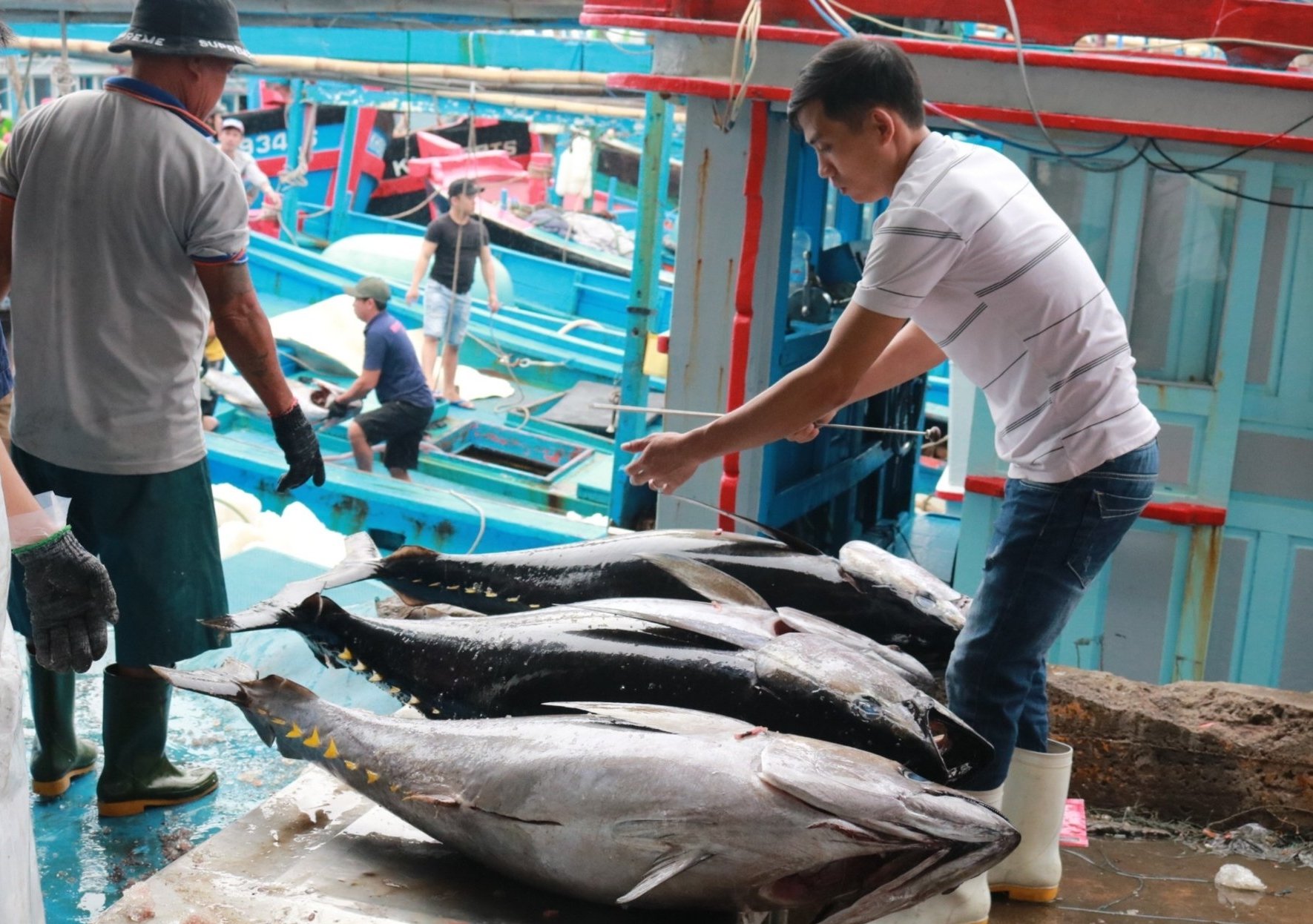October 23, 2025 | 03:14 GMT +7
October 23, 2025 | 03:14 GMT +7
Hotline: 0913.378.918
October 23, 2025 | 03:14 GMT +7
Hotline: 0913.378.918
According to the Vietnam Association of Seafood Exporters and Producers (VASEP), after a sharp increase of over 20% in May, seafood export turnover in June still exceeded the same period last year, but growth slowed significantly to just 4%, reaching USD 876 million. This was largely due to a 26% year-on-year drop in exports to the US.
In the first six months of 2025, Vietnam’s seafood exports reached USD 5.2 billion, a nearly 19% increase compared to the same period in 2024. Exports to the US reached USD 891 million, still up 16% thanks to a surge in shipments ahead of the July 9 deadline, when the US implemented new countervailing duties. However, by June, many Vietnamese companies had proactively suspended exports to the US to avoid high tariff risks.

By the end of June 2025, Vietnam's shrimp export turnover reached 2.07 billion USD, up 26% over the same period last year. Photo: Hong Tham.
In contrast, markets such as China, Japan, South Korea, and ASEAN continued to post strong growth in June, ranging from 15% to nearly 28%.
Meanwhile, exports to the EU plateaued, dipping slightly by 1%, and exports to the Middle East dropped sharply by 16% due to ongoing conflicts in the region. Notably, exports to Israel, a major market for canned tuna, fell by over 50%.
Vietnam’s two main seafood export products, shrimp and pangasius (tra fish), have seen growth slow due to the US’s tariff measures. By the end of June, shrimp exports had reached USD 2.07 billion (up 26%), while pangasius exports totalled USD 1 billion (up 10%).
Prospects for the second half of 2025 for these two key products will hinge entirely on the US’s countervailing duty policies. Shrimp, in particular, is at risk of facing a "triple tariff threat": countervailing duties, anti-dumping duties, and anti-subsidy duties.
There is more optimism for the pangasius industry after the US Department of Commerce (DOC) recently released the final results of its 20th administrative review (POR20), in which seven Vietnamese companies were granted a 0% anti-dumping duty. If upcoming countervailing tariffs are managed well, this could open up a breakthrough opportunity for Vietnamese pangasius.
Tuna suffered the steepest decline among seafood categories in June, with exports falling by over 31% year-on-year, mainly due to tariff barriers from the US, which accounts for a large share of Vietnam’s tuna exports. In the first half of the year, tuna exports decreased by nearly 2%. In response, Vietnamese exporters are actively exploring new markets such as Egypt and Lithuania.

Tuna was the group with the sharpest decline in June, down more than 31% compared to the same period last year. Photo: Kim So.
Since 2023, Vietnam’s tuna exports to Egypt have been growing steadily. According to Vietnam Customs, in the first four months of 2025, tuna exports to Egypt reached nearly USD 4 million, a 72% increase compared to the same period in 2024.
Canned tuna is Vietnam’s top export to Egypt, accounting for over 82% of total tuna export value. The remainder comprises other processed tuna products and frozen tuna fillets/loins.
Currently, Thailand is Egypt’s primary supplier of canned tuna. However, many Egyptian importers are seeking alternative partners, including Vietnam, to reduce dependence on a single source. This presents an opportunity for Vietnamese businesses to gain market share in Egypt.
Lithuania, serving as a gateway to Eastern Europe, is another promising destination. According to the International Trade Centre (ITC), Lithuania ranks 12th among EU seafood importers, making up 1.2% of the EU’s total seafood import value. Vietnam was the sixth-largest non-EU seafood supplier to Lithuania in 2022, accounting for 3.54% of the EU’s total seafood imports.
Vietnamese Customs data shows that tuna exports to Lithuania surged from USD 229,000 in 2021 to nearly USD 16 million in 2024, a 69-fold increase. In the first five months of 2025 alone, tuna exports to Lithuania doubled year-on-year to more than USD 8 million. Frozen tuna fillets/loins (HS code 0304) are the primary product exported to this market, representing 98% of total export value.
With major export markets like the US and EU facing numerous challenges, Egypt and Lithuania are emerging as viable alternatives for expanding Vietnam’s tuna exports. However, other countries are also targeting these markets, intensifying competition. Vietnamese companies must proactively adapt to secure market entry.
Two scenarios, both below USD 10 billion
VASEP outlines two export scenarios for the second half of the year. In the first, if US countervailing duties after July 9 are set at 10%, total seafood exports in 2025 could fall to around USD 9.5 billion, USD 500 million less than previously forecast. Other markets such as China, ASEAN, Japan, and the EU may absorb part of the redirected supply from the US.
In the second scenario, if countervailing duties exceed 10%, potentially reaching 46%, Vietnam’s seafood exports could plunge to USD 9 billion or lower. The US would no longer be a stable market, particularly for products with complex supply chains. In this worst-case scenario, countries with lower tariffs, such as Ecuador, India, Thailand, and Indonesia, would gain a competitive edge. While neutral markets like Japan, the EU, and ASEAN may offer some compensation, the recovery in global consumption remains weak, limiting their capacity to offset losses.
Translated by Linh Linh

(VAN) After the Philippines suspended rice imports for several months, Vietnamese enterprises have been proactively seeking new markets, with Africa emerging as a promising destination.

(VAN) Ms. Chu Thi Hong Thuy, CEO of Tafa Group, stated that eggs are the second fastest-growing livestock product globally, with an annual growth rate of 2%.

(VAN) In the first eight months of 2025, Japan imported coffee from 59 countries and territories around the world.

(VAN) On October 11 in Ca Mau, Thanh Nien Global Trading Joint Stock Company held a signing ceremony for a cooperation agreement on the supply of aquatic raw materials with 20 cooperatives across the province.
/2025/10/12/4316-1-105513_39.jpg)
(VAN) Vietnam's frozen pangasius fillets have become a popular product among U.S. consumers and are now present in major supermarket chains across the U.S.

(VAN) Transitioning to organic dragon fruit cultivation marks a shift from 'productivity-oriented agriculture' to 'economic agriculture', requiring lower investment and risk but delivering higher efficiency.

(VAN) Exporting pomelos to Australia carries significance beyond commerce, it demonstrates the credibility of Vietnam’s plant quarantine system in the global integration process.